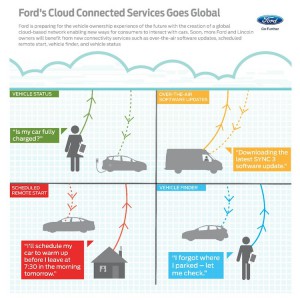
Ford's new partnership with Microsoft lets the automaker use a cloud-based system to provide over-the-air updates.
Ford Motor Co. has entered into a new alliance with Microsoft to develop a cloud-based Ford Service Delivery Network that opens a way to offer new services to vehicle owners.
By teaming up with Microsoft, Ford can expand connected services for customers around the world using the globally scalable and reliable Azure Cloud infrastructure, according to Ford spokesman Alan Hall.
Ford and Lincoln owners will benefit from the convenience of new connectivity services keeping them better informed and in control of their vehicle at all times with the expanded availability of features like scheduled remote start, vehicle finder and vehicle status, such as fuel or charge level, tire pressure.
Microsoft’s cloud-based storage systems have already earned solid marks from users.
It isn’t exactly a new idea. Mazda already uses the same Microsoft service and General Motors has offered service updates via OnStar for several years now.
In one of the largest demonstrations of how the new technology can work, BMW repaired more than 2.2 million vehicles earlier this year by sending an over-the-air patch to fix an electronic flaw in the vehicles.
The flaw would have allowed hackers to open doors using just a mobile phone. BMW, Rolls-Royce and Mini vehicles were all affected as the problem was in the Connected Drive service, which allows drivers to control functions like doors and infotainment from their smart phones.
BMW did not confirm the flaw or the subsequent fix until after the fixes had been made.
Building the Ford Service Delivery Network on the Microsoft Azure platform enables a common platform for Ford to bring new features and services to market faster, quickly scale up for global implementation, and remain flexible for the future, Ford officials said.
Starting later this year, the Service Delivery Network will first enable over-the-air software updates for SYNC 3. In the future, it will support the migration of our existing connected services, MyFord/MyLincoln Mobile, offering expanded global availability.
Mark Fields, Ford’s chief executive officer, has also said that Ford will have to change the business models that it utilizes in the future as consumer needs evolve with the introduction new technology or services.
(Ford aims to speed up, simplify with launch of Sync 3. For more, Click Here.)
As consumers shift toward more cloud-based services, the Ford SDN architecture is a strategic approach to stay up-to-date and ready for the future by making it easy to add or evolve features during the vehicle ownership period or offer new mobility solutions.
Gary Flom, president of Bay Ridge Ford in Brooklyn, New York, the Cloud-based platform may also provide insurers with information about vehicle usage and owners’ driving habits.
(Click Here for details about how automakers are struggling with privacy issues in connected cars.)
Several insurers among them Progressive, State Farm and Travelers, have answered consumer demands for lower rates by offering pay as you go premiums, which utilizes telemetric technology to monitor how customers use their vehicles. Customers are invited to install the black boxes on their vehicles with the promise of discounts of up to 50%.
Progressive’s Snapshot tracks how often you brake hard, how many miles you drive each day, and how often you drive between midnight and 4 a.m. Some Snapshot devices use GPS to track location, which Progressive says is just for research purposes.
(To see more about makers scrambling to bolster in-car cyber security, Click Here.)
By their very nature, monitoring systems require enormous amounts of data storage and security, offering Ford’s new alliance with Microsoft could offer Ford a service that could tap into a new revenue stream.

In bed with the Devil is not going to be good for customers…